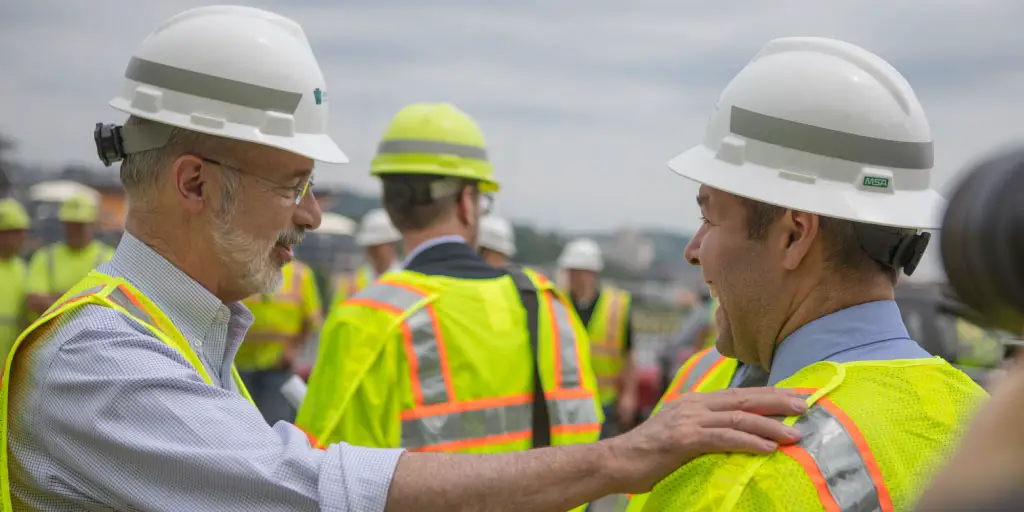 HARRISBURG, Pa. – Governor Tom Wolf recently signed Senate Bill 172, the Automated Speed Enforcement in Work Zones legislation, which aims to deter speeding in work zones and ultimately improve motorist and roadway worker safety.
HARRISBURG, Pa. – Governor Tom Wolf recently signed Senate Bill 172, the Automated Speed Enforcement in Work Zones legislation, which aims to deter speeding in work zones and ultimately improve motorist and roadway worker safety.
“Crashes, injuries, and deaths that occur because of speeding are completely preventable, and this law is a major step in enhancing safety in Pennsylvania’s work zones,” Governor Wolf said. “We always urge people to drive safely, and this is especially critical for those working within and driving through work zones.”
This new law has three key provisions, one of which allows the Pennsylvania Department of Transportation (PennDOT) and Pennsylvania Turnpike Commission (PTC) to perform a five-year pilot program in which some construction and maintenance work zones will have cameras equipped with LIDAR or radar to take photos of license plates of any vehicle exceeding the work zone speed limit by 11 mph or more when workers are present.
If a violation is committed, a Pennsylvania State Police representative will review it and then a notice of violation will be issued to the registered vehicle owner. The first violation is a warning, the second violation results in a $75 fine and the third and subsequent violation means a $150 fine. Violations will not be subject to driving points or merit rating for insurance purposes. The law allows PennDOT and the PTC to choose which contractor or department-force work zones on the federal aid highway system to use in the pilot. Special advanced signage advising motorists of the camera enforcement have to be erected at the affected work zones.
In anticipation of the bill’s signing, officials from PennDOT, the PTC, the City of Philadelphia, the American Council of Engineering Companies, the Associated Pennsylvania Constructors, the Associated Pennsylvania Constructors and American Automobile Association held an event in Philadelphia this morning to mark its importance.
“I am thrilled that the Legislature and Governor have taken this step that aims to save the lives of our employees, motorists, and our partners in the contracting community,” PennDOT Secretary Leslie S. Richards said. “We have seen some speeds in work zones that are simply unacceptable, and we are confident that this tool will drive down speeding violations.”
PennDOT, the PA Turnpike, and the Pennsylvania State Police (PSP) are working to develop a Request for Proposals for a vendor to administer the system and provide the hardware. The selected vendor will be compensated per a flat fee and not per violation.
“We have advocated for this safety measure for a long time and I am confident that it will be a game-changer for worker safety in Pennsylvania,” PTC CEO Mark Compton said. “While this law is not a cure-all, it echoes our continued efforts to improve safety on our roadways.”
Fines paid for these violations, minus the costs to operate and maintain the program will be deposited into the Motor License Fund. Of those fines, in the first three years 45 percent of the fines will be transferred to the PSP for recruiting, training, and equipping cadets as well as increased state trooper presence in work zones. Fifteen percent will be invested in work zone safety, traffic safety, and educating the public on work zone safety. After the third year, PennDOT or the PTC will use fine revenues to develop a Work Zone and Highway Safety Program for improvements and countermeasures to improve work zone safety.
The law aims to address ongoing safety concerns in work zones. Forty percent of all work zone crashes involve speeding. Crashes in work zones on Interstates and the Turnpike increased from 618 in 2012 to 1,008 in 2016. There has been a 5 percent increase in the average annual rate of work zone crashes statewide from 2012-2016, increasing from 1,661 in 2012 to 2,075 in 2016.
As an additional provision, the legislation establishes a five-year pilot program within the City of Philadelphia for speeding enforcement cameras. Automated speed enforcement zones will be permitted along the entire length of U.S. 1 (Roosevelt Boulevard) between Ninth Street and the Bucks County line. As with the work zone pilot, special signage advising motorists of the camera enforcement have to be erected denoting the automated speed enforcement zone.
“Our city and our families deserve safer streets,” said Mayor Jim Kenney. “Managing speeds to save lives is a cornerstone of Vision Zero. With around 100 people being killed in traffic crashes on Philadelphia streets every year, we are committed to continuing to bring to together street design, education, enforcement, and policy changes that will manage speeds and, thus, save lives making Philadelphia streets safe for everyone.”
City Council must adopt an ordinance to begin a pilot program. The Philadelphia Parking Authority is designated as the system operator and cameras will be equipped with LIDAR or radar.
The third provision in the law allows the use of LIDAR speed-measuring devices for the automated speed enforcement programs and PSP.
The law establishing the PennDOT and PTC pilot program takes effect in 120 days and violations can be issued 60 days after publication in the PA Bulletin. The law provisions for the City of Philadelphia pilot program take effect in 60 days. PennDOT must establish a temporary regulation for the calibration and testing of LIDAR speed-measuring devices before it can be used for automated enforcement or by PSP.
Information on work-zone laws and safety in Pennsylvania is available at www.penndot.gov/safety in the “Work Zone” traffic safety and driver topic page.
Copyright © 2024 EYT Media Group, Inc. All rights reserved. Any copying, redistribution or retransmission of the contents of this service without the express written consent of EYT Media Group, Inc. is expressly prohibited.








